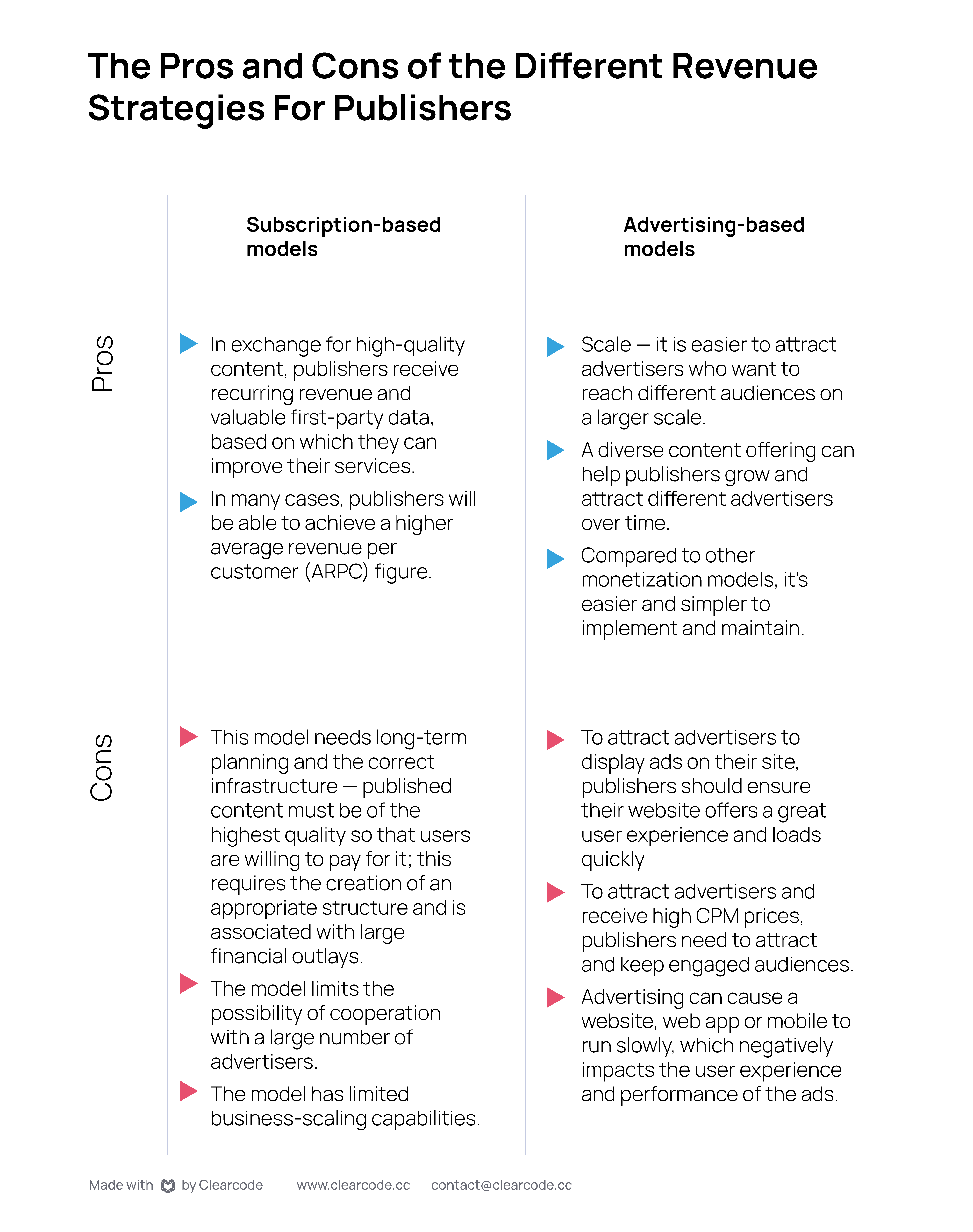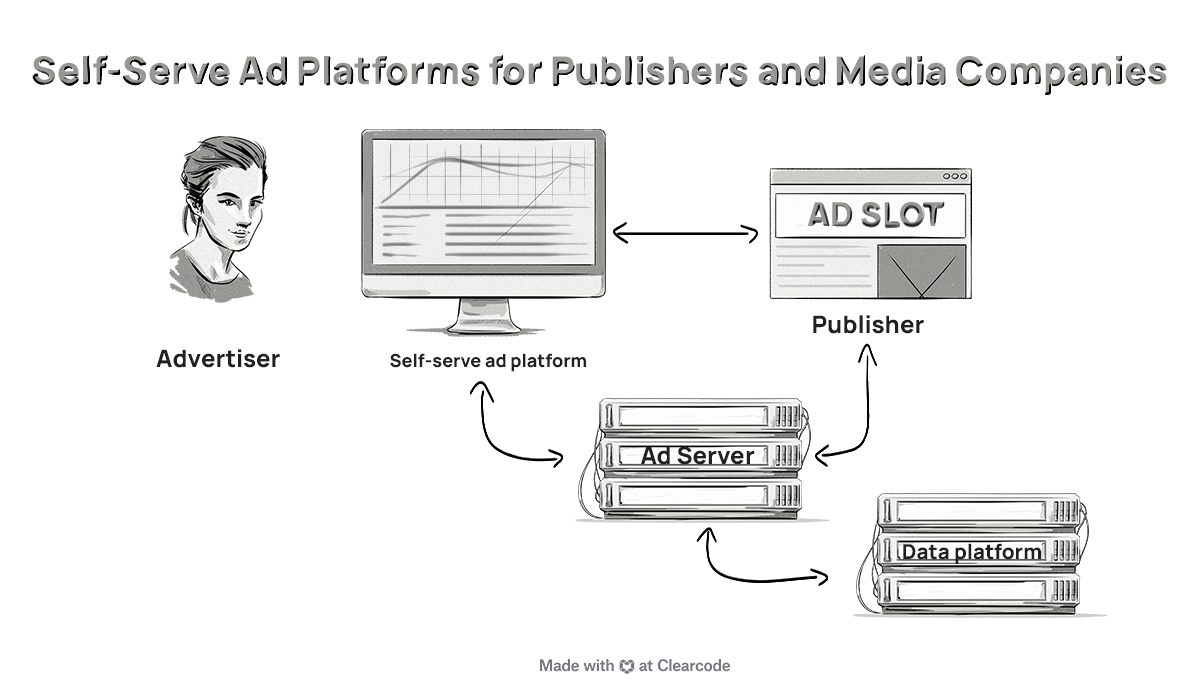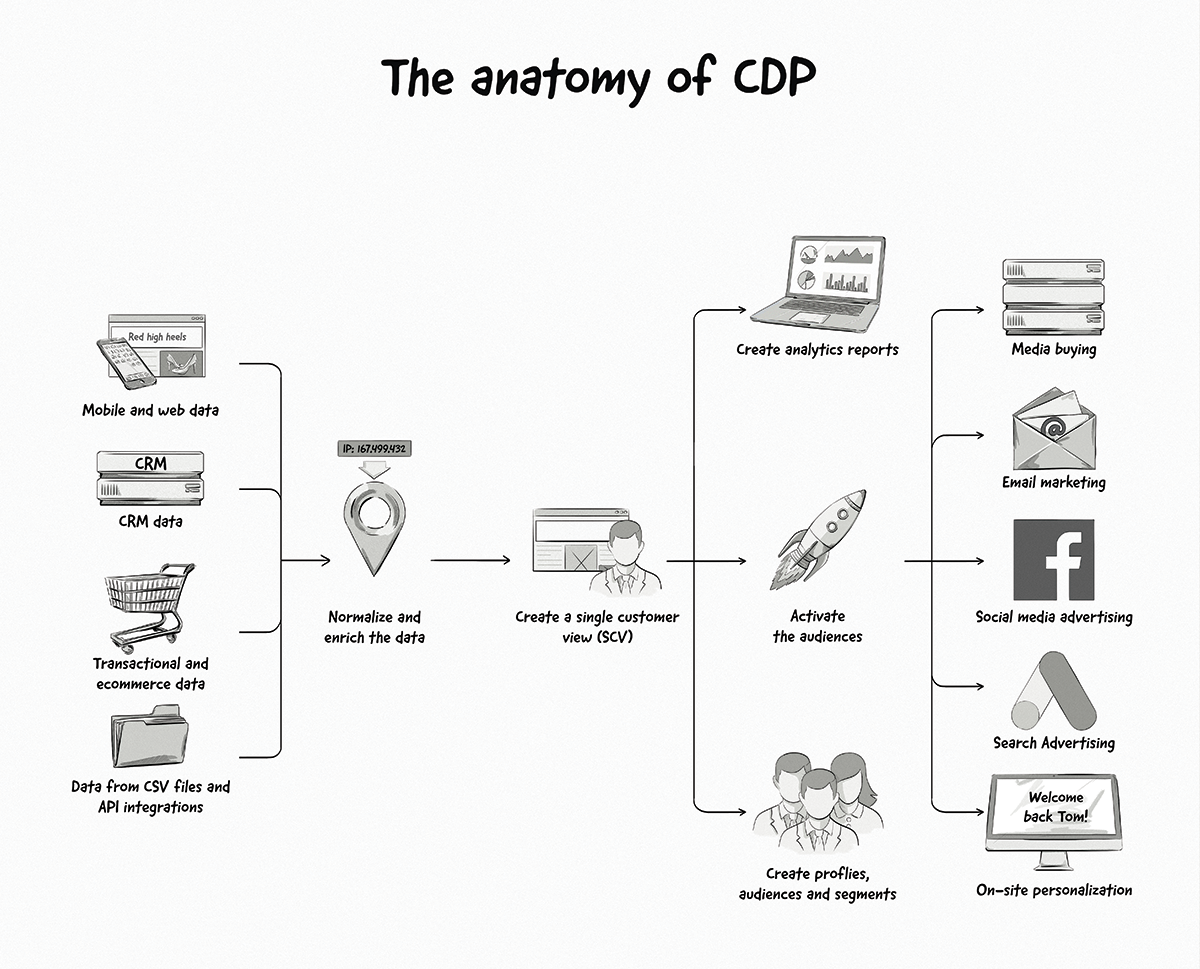When advertising made its way to the online world back in 1994, many news publishers adopted the advertising model as a way to generate revenue from their online publications. Since then, publishers have experimented with many other popular monetization models, such as subscriptions.
In this article, we look at the main ways publishers, app developers and media companies can generate revenue and how AdTech solutions like header bidding, self-serve ad platforms, customer data platforms (CDPs) and demand-path optimization can help them create new revenue streams and increase revenue.
Key Points
- Many publishers, app developers and media companies employ subscription-only plans and advertising to generate revenue.
- Subscription-only plans involve charging a recurring fee for access to content. This can include news articles, educational material, as well as video entertainment and live sporting content.
- The advertising model benefits both parties as users can access content for free and publishers and media businesses can generate recurring revenue.
- One of the most popular models among publishers is a mix of paid subscriptions and displaying ads on their websites, mobile apps, streaming services, etc.
- Due to the fact that, in most cases, the subscription model will be ad-free, it enables publishers to provide customers with a choice between paying for an ad-free subscription or receiving content for free or at discounted price but being shown ads.
- Advertising technology (AdTech) creates monetization opportunities for publishers, with many AdTech platforms enabling publishers to manage and sell their available inventory, offer their inventory and audiences to advertisers directly via self-serve advertising platforms, collect and leverage data for ad targeting and audience insights, and optimize and streamline their cooperation with advertisers.
- Some of the most common AdTech solutions for publishers include header bidding, self-serve ad platforms, customer data platforms (CDPs) and demand-path optimization (DPO).
Subscription-Only Plans
Subscription-only plans involve charging a recurring fee for access to content. This can include news articles, educational material, as well as video entertainment and live sporting content.
Solo entrepreneurs, small companies and media companies, such as streaming services, are the most common types of publishers who run their businesses solely on subscriptions.
There are a few reasons why publishers choose this model.
First of all, they provide high-quality content as it is often unique, contains a lot of valuable knowledge and opinions, and has verified sources. By offering their content via a subscription, publishers can create “products” for monetization.
Secondly, many subscription-only publishers aim to provide their customers with a good user experience. Thanks to the subscription model, publishers can marry a good user experience with a fitting monetization model and offer users an easy-to-use interface, fast-running website and application, and an ad-free experience.
Thirdly, they want to protect their customer data from being shared with other companies. A publisher’s first-party data is often their most valuable asset, but its value can be easily diluted if it’s shared across the wider programmatic advertising ecosystem and mixed in with data from other publishers.
Publishers that rely solely on subscriptions for their business model acquire first-party data when their users purchase a subscription. This information is often used to improve the user experience and upsell users to higher tier plans.
Currently, few publishers decide to generate revenue from this model alone as most make their web properties and mobile apps available to advertisers or operate using a model consisting of both advertisements and subscriptions.
Netflix and Disney started off with ad-free, subscription-based streaming services until recently, with each of them now developing ad-supported tiers.
Putting content behind a paywall has been a global trend, although it may change in the upcoming years as one-third of U.S. consumers feel overwhelmed by the quantity of subscriptions they must handle.
We Can Help You Build an AdTech Platform
Our AdTech development teams can work with you to design, build, and maintain a custom-built AdTech platform for any programmatic advertising channel.
Advertising Revenue
For most publishers and media companies, advertising has always been one of their primary revenue streams. It’s a popular model that benefits both parties as users can access content for free and publishers and media businesses can generate recurring revenue.
However, this is starting to change.
According to Reuters Institute’s Journalism, Media, and Technology Trends and Predictions 2022, display advertising was considered an important source of income by 81% of publishers in 2020 but this dropped to 73% in 2022. Native advertising also saw its popularity among publishers as a revenue source drop from 76% in 2020 to 59% in 2022.
Advertisements on websites can take various forms, such as banners, pop-ups, video ads, etc. Many publishers and media companies display various forms of advertising on their website to diversify their ad revenue.
While advertising offers a fairly consistent source of revenue, publishers using this model face many challenges, such as achieving high fill rates, ad fraud, ad blockers and privacy settings, and properly collecting user data, segmenting it and making their audiences available to advertisers.
Users’ attitudes toward websites also affects publishers’ ad revenue streams — if users find adverts relevant, they will interact with them (e.g. click on them); otherwise, they’ll simply ignore them.
Below are some example of publishers using the advertising-only model:
Hybrid: Subscriptions and Advertising Revenue
One of the most popular models among publishers is a mix of paid subscriptions and displaying ads on their websites, mobile apps, streaming services, etc. Due to the fact that, in most cases, the subscription model will be ad-free, it enables publishers to provide customers with a choice between paying for an ad-free subscription or receiving content for free or at discounted price but being shown ads.
Also, it enables the publisher to make money from two separate sources.
Below you’ll find a list of publishers that offer a hybrid of paid subscriptions and advertising revenue:
- YouTube
- The Washington Post
- Business Insider
- Spotify
- Vimeo
- Cosmopolitan
- Esquire
- Food & Wine
- The Diplomat
- CNBC
- Financial Times
- Travel and Leisure
- Fashion United
- The Independent
- Vox.com
- The Guardian
- South China Morning Post
The main challenges that publishers face with the hybrid mode include:
- Building and handling long-term relationships with their audiences.
- Converting users from freemium plans — free, time-limited access — to paid content and paid subscription plans.
- Setting reasonable and competitive subscription fees that allow them to attract and keep subscribers but also enable them to fund content production.
- Creating user profiles for personalization, e.g. single customer views in a customer data platform (CDP) or a customer relationship management (CRM) system.
- Managing first- and third-party data and using it for content personalization and ad targeting.
The Pros and Cons of the Different Revenue Strategies For Publishers
Choosing the right strategy is important for creating long-term revenue streams for publishers. These models allow publishers to attract new users, create and grow new revenue streams, establish business partnerships with advertisers, monetize content, etc.
Data-based decisions will help publishers choose the best approach and create a model that will become a stable revenue stream.
In the table below, we briefly discuss the most important pros and cons of the subscription and advertising models.

The biggest advantages of the advertising-based business model is greater flexibility in selecting ad partners and the ability to scale the business.
Subscription-based models require long-term planning in terms of preparing CRMs, paywalls and cash flow. Finding and monetizing an audience willing to pay for access to content can also be a challenge.
Digital advertising offers the opportunity to test and validate cooperation with various advertisers and optimize the processes related to the delivery of ad campaigns.
However, publishers who fully rely on advertising need to constantly maintain their website’s performance and focus on the UX, for example, to appear higher in Google Search’s rankings to attract visitors.
On the other hand, a well-maintained website with valuable content will help to retain users and convert them into subscribers.
Opportunities for Publishers in AdTech
Advertising technology (AdTech) creates monetization opportunities for publishers, with many AdTech platforms enabling publishers to manage and sell their available inventory, offer their inventory and audiences to advertisers directly via self-serve advertising platforms, collect and leverage data for ad targeting and audience insights, and optimize and streamline their cooperation with advertisers.
Below we describe the most important AdTech solutions that can help publishers create new revenue streams and increase their revenue.
Header Bidding
Header bidding (HB) is a process whereby publishers make their ad inventory available to advertisers before their ad server selects which ad to display. When a publisher puts ad space up for sale, advertisers make offers to buy this space. The bids are collected simultaneously and the whole process takes place in real-time while the page is loading.
The concept behind header bidding is to allow publishers to collect bids from advertisers and then make them compete with the deals in their ad server, e.g. direct deals. By doing this, publishers can increase their ad revenue and allow advertisers to reach their target audience.
Publishers leverage header bidding to maximize their monetization potential. A study from 2020 showed that header bidding increases fill rate by 23% and average CPMs by 20%.
How does header bidding create opportunities for publishers?
- More transparency: By giving publishers more insight into the bidding process, they may better grasp the value of their inventory and make wiser choices.
- Higher fill rates: The more demand sources a publisher has access to, the higher the chances are for the publisher to sell all types of their ad inventory, including both premium and remnant (unsold) inventory.
- Increased competitiveness: Header bidding enables several demand sources to simultaneously bid on the same piece of inventory, increasing competition and driving up CPMs for publishers.

Self-Serve Ad Platform
A self-serve advertising platform is a piece of advertising technology with which advertisers and ad agencies can create, run and manage advertising campaigns on a publisher’s website by themselves, without having to involve the publisher’s AdOps team.
The main benefit of a self-serve ad platform for publishers is that their AdOps teams can focus on more important ad campaigns and clients, rather than on every media buyer.
Publishers can integrate data platforms, such as DMPs and CDPs with the self-serve ad platform to collect, store and process data, and create audiences. When integrated with an ad server, a self-serve ad platform powers ad delivery and ad targeting processes.

Source: Clearcode.cc
A Customer Data Platform (CDP) for Building Audiences
Privacy protection trends have impacted the way publishers cooperate with advertisers in terms of collecting and exchanging information about users. Regulations such as GDPR, ePrivacy directive, DMA and DSA, and CCPA regulate the processes for gathering and sharing personal data, for example, for advertising purposes.
The most valuable currency on the digital advertising market currently is first-party data, i.e. data that the user provides to the publisher themself. The publisher, provided they’ve obtained the appropriate consents, can use the data for building audiences and, ultimately, advertising purposes.
A piece of software that gathers information from several sources and displays them in a single customer view (SCV) is called a customer data platform (CDP).
CDPs mainly gather first-party data and utilize it for a variety of tasks, including marketing, customer support, and advertising.

To create a monetization opportunity, publishers, such as the French-based Le Monde, built their own consent management platform and merged their functionalities with a custom CDP for its subscribers that serves as a data management platform for its advertisers.
For large publishers, it makes sense to partner up with advertisers that share common brand values and can target similar audiences. Examples of companies that would have matching audiences include:
- Culinary websites and food companies
- Real estate agencies and home renovators
- Tech sites and electronics brands
Demand-Path Optimization (DPO)
Demand-path optimization (DPO) is a process by which publishers analyze the path that media buyers (advertisers and ad agencies) take to purchase their inventory.
Publishers use DPO to learn about the parts of the media supply chain that are beneficial to them and those that can be improved. The process helps boost ad income and yield, saves AdTech costs, and enhances the user experience on their websites and applications.
To conduct DPO, publishers will take into account several factors. These include:
- Transaction costs.
- The transparency of the purchasing path.
- The ease of reaching the desired inventory for buyers.
- The overall attractiveness of the offers presented to them.
- Ad revenue.
With DPO, each chain of the path is analyzed: Supply-side platforms (SSPs), exchanges, ad networks, trade desks, and demand-side platforms (DSPs).
Business Benefits for Publishers
The process brings many business opportunities for publishers.
- Buyer identification: Publishers know exactly who buys their impressions. They can use the IAB’s Buyer.json mechanism for that purpose and gain more transparency into their media-supply chain.
- Path identification: Publishers recognize effective and ineffective paths of buying their inventory.
- Elimination of bad actors: Publishers can get rid of ad fraudsters and shady media buyers.
- Value recognition: Publishers can recognize ad exchanges and SSPs that take fees and not deliver enough value in terms of ad revenue.
- Increased transparency: Publishers can reorganize their media-buying paths and make it easier for advertisers to buy more impressions.
- Improved relations with advertisers: DPO processes promote direct meetings with media buyers, so the relationships with them can be strengthened.
- Risk mitigation: Publishers can recognize and weed out advertisers with low credit scores, and those who pay their bills after the due date.
- A better user experience: Publishers recognize advertisers that display low-quality ads and slow down the website.
Summary
For publishers, there is no one-size-fits-all strategy for creating monetization models. Choosing the best strategy can depend on the size of the publisher, amount of its users, the content it delivers, etc.
What is more, publishers will face many challenges such as obtaining data and consent from users, delivering targeted ad campaigns, and making decisions about their websites. However, on many levels, AdTech solutions can help solve these problems.
We Can Help You Build an AdTech Platform
Our AdTech development teams can work with you to design, build, and maintain a custom-built AdTech platform for any programmatic advertising channel.






